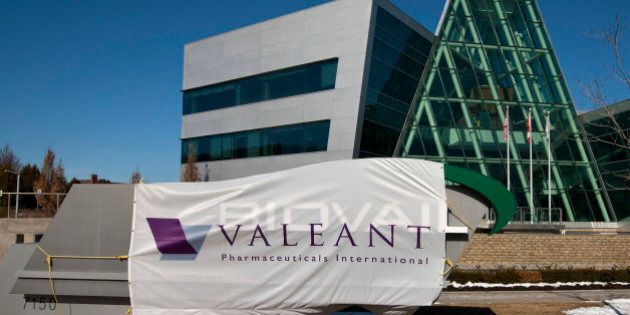
You probably already know that over the last year, ending July 31st, the Canadian stock market index (S&P/TSX) declined -5.62%. Over this same period, Valeant Pharmaceuticals (VRX) has increase from $127.83, closing on Friday, July 31st, at a price of $335.32. That's an increase of 119.38%, with 78.28% of that in this calendar year alone.
You may also know that the Canadian stock market index is not only comprised of the largest publicly traded stocks in Canada but that their representation on the index is based on their size, measured by their market capitalization. The market-cap of a company, as it's often referred to, is the number of shares outstanding multiplied by the company's share price, which provides a standard way to measure this dimension.
Looking back to the end of last year's second quarter, VRX had a $41.861 billion market-cap, making it the ninth largest publicly traded company in Canada, representing 2.24% of the total S&P/TSX stock market index. One year later, the market-cap, driven by its disparate price increase, made VRX the 3rd largest publicly traded stock in Canada at $88.775 billion, next to Toronto Dominion Bank and Royal Bank of Canada.
According to First Asset Management, VRX's rise over the last year contributed roughly 3.7% to the total return to the S&P/TSX index (source: Morningstar Direct). Without the extraordinary ascent of VRX, the total S&P/TSX index would have dropped by nine and a third percent (-5.62% - 3.72% = -9.34%) over the last twelve months, had VRX not been on a rampage.
No one minds volatility of any company when it is in the up direction however, the disproportionate growth of any company shouldn't go unnoticed. Coupled with that, many investors are not even aware of this anomaly or that they may own this stock indirectly. Anyone who invests in a mutual fund, ETF or other portfolio that tracks the S&P/TSX, holds a proportion of VRX by definition since it has just gained the auspicious title as the largest publicly traded company in Canada, after most recently usurping the Royal Bank of Canada in market-cap.
Our memories are not too short to have forgotten the rise of another Canadian stock in 2000. After being spun off by BCE during the technology speculation bubble, the market-cap of Nortel Networks peaked at $398 billion dollars giving it a weight of more than a third of the entire S&P/TSX market value. With a top price of $124.50 per share, many investors contemplated buying more stock when the price dropped below $20, then $18, then $10. Finally, at 47 cents, the company pursued creditor protection in 2009, ultimately ceasing operations a few years later.
My intention isn't to predict anything about the future of VRX. Instead the message is a reminder of how holdings in any market-cap weighted investment vehicle is impacted by the change in size of its constituents. When any one position has a disproportionate participation in the whole, investors would be wise to take note and closely monitor the future effect that an individual issuer may have on the whole. The make-up of any portfolio isn't always apparent until you do a little digging. Even if the investment contents are listed, sometimes it isn't what is held in the vehicle that is most important but rather how those holdings have changed and may change over a period of time.
This information should not be construed as investment advice, nor can it take into account your own specific circumstances. The opinions formulated within this article are based on sources believed to be reliable and may not reflect the opinions of any organizations that I am affiliated with.
ALSO ON HUFFPOST:
